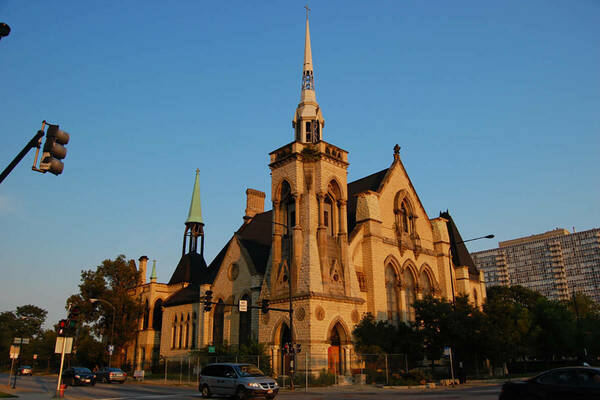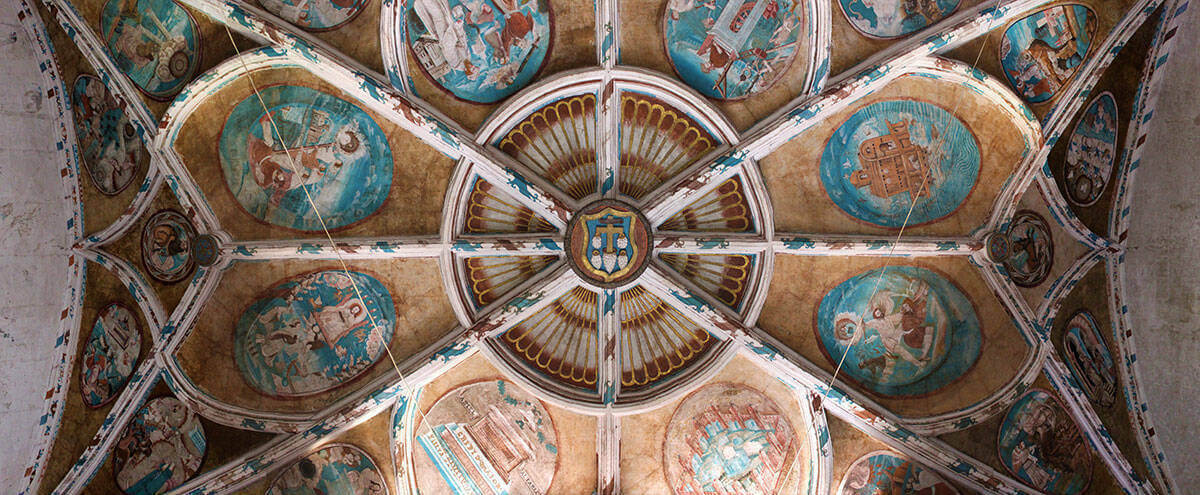
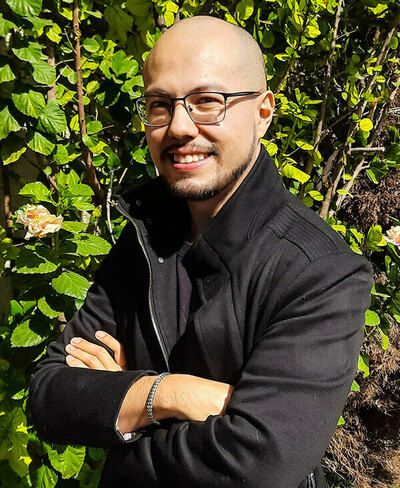
When University of Notre Dame Ph.D. student Carlos Diego Arenas Pacheco stepped into the 16th-century Church of the Franciscan Monastery in Tecamachalco, Mexico, he was overwhelmed with emotion.
The paintings on the temple’s vaulted stone ceiling depict scenes of the Old Testament and the Apocalypse of St. John — classical European renaissance images rendered in a color palette of rich golds, vivid reds, and sharp turquoise blues.
Created by indigenous artist Juan Gerson on ovals of traditional Mexican amate paper made of ficus bark, the artwork represents a merging of Aztec and Spanish cultures in its use of pre- and post-Conquest materials, imagery, and styles.
This synthesis is at the heart of Arenas Pacheco’s research in Notre Dame’s Medieval Institute on the transmission — and transformation — of culture from one part of the world to another.
“Seeing these works of art in front of me that I have studied and been so interested in, just from photographs and books, was amazing,” he said. “They represent the birth of Christianity in Mexico — the culture I come from — and a combination of indigenous and Spanish heritage that is just incredible.”
For his dissertation, Arenas Pacheco is exploring how a European-style education was used to teach indigenous children in 16th-century Mexico and how they transformed that education into works of art and literature.
“The indigenous population responded to that education not by assimilating it as an imposition, but they took it as an opportunity to create something of their own using the new tools they had at their disposal,” he said.
While many scholars have examined the early connections between Europe and the Americas, Arenas Pacheco said that most approach the issue from one perspective or the other. Americanists tend to emphasize that the Spanish influence was an imposition and that indigenous culture was destroyed, he said, while scholars of European history focus on evangelization and acculturation.
Arenas Pacheco, however, seeks a balance between the two and argues that indigenous culture in Mexico did not disappear — but was remade into something different, not only by the hands of the Europeans, but also by the hands of the indigenous peoples themselves.
“Scholars shouldn’t overlook the fact that the history of the Americas is the history of transformation, the creation of something new from the clash of cultures — and this is something that didn’t happen anywhere else in the world,” he said. “This new culture that developed in early Mexico is as much indigenous as it is European.”
“Scholars shouldn’t overlook the fact that the history of the Americas is the history of transformation, the creation of something new from the clash of cultures — and this is something that didn’t happen anywhere else in the world. This new culture that developed in early Mexico is as much indigenous as it is European.”
A creative culture
When the Spanish conquered Mexico in the 16th century, European missionaries established educational projects for the indigenous populations, particularly the Nahuas. Some elite boys, and occasionally girls, received an education that was quite advanced for that time period — and equal to the level of a European education.
“They learned Latin. They learned how to write,” Arenas Pacheco said. “They read all the classics from Cicero and Julius Caesar, and they read the philosophy of Aquinas and Duns Scotus.”
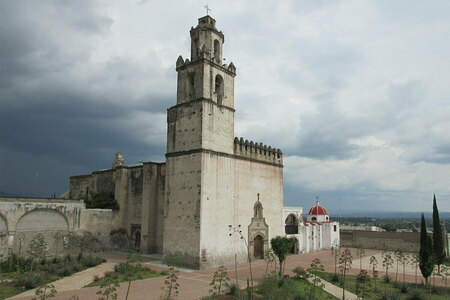
Those educated went on to serve as political leaders in their communities and as intermediaries between the Spanish and other indigenous peoples. Their education provided them with a social and political tool, with which they were able to defend their legal rights and lands in the Spanish court system, and inspired them to create pieces of art and literature.
“Even though very few of them went to Europe, or left their own communities, we have hundreds of examples of frescoes and paintings by Aztec artists that show how conscious they were of the world outside of their own community,” Arenas Pacheco said. “Their creations show how they interacted with and sought to be at the same level as European writers and artists.”
Arenas Pacheco emphasizes that his research has a social, as well as scholarly, message for the hundreds of indigenous communities still in Mexico today who often face discrimination.
“Indigenous and mixed cultures are just as complex and refined and deep as other cultures,” he said. “Instead of seeing them as backward, we should take pride in that heritage and see them for what they are — creators.”
A more complete vision
Arenas Pacheco studied philosophy for his bachelor’s degree at LaSalle University in Mexico City, as well as his first master’s degree at Universidad Autónoma Metropolitana, where he wrote his thesis on 13th-century Franciscan philosopher Duns Scotus.
He was drawn to Notre Dame’s Medieval Institute because of its multidisciplinary nature.
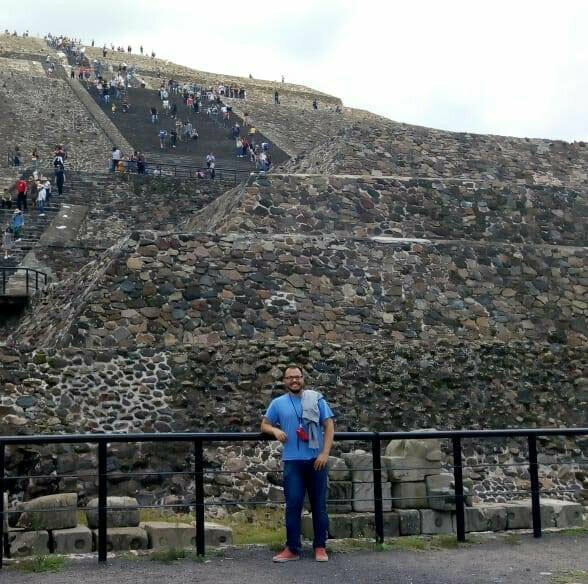
“You can do work that transcends boundaries of any kind here — geographical, chronological, or disciplinary,” Arenas Pacheco said. “And that’s the kind of work I want to do. If you mention Mexico, no one would think Middle Ages, and if you mention Middle Ages, no one would think of Mexico. But the Medieval Institute has been very open to and supportive of my research, and I think my work is opening people’s minds a bit and stretching the traditional concept of the old world.”
Arenas Pacheco, whose advisors include professors Martin Bloomer from the Department of Classics, Karen Graubart from the Department of History, and Michael Schreffler from the Department of Art, Art History & Design, said that the institute’s interdisciplinary nature has also affected the trajectory of his research.
He came to the Medieval Institute planning to trace the influence of Duns Scotus’s teachings in 16th-century Mexico. But after discussing his plan with Notre Dame faculty, he realized his project needed to both delve deeper and possess a wider vision of the cultural phenomenon occurring in Mexico at that time.
“I realized then that I needed to focus on the history of education and the beginnings of evangelization through education first,” he said. “Now, my dissertation not only responds to questions about the history of philosophy or ideas but also examines questions about the history of culture and how Christianity transforms itself and other cultures when it comes into contact with new faithful. It gives a wider and more complete vision of what happened culturally in that era in early Mexico.”
“The history of a small indigenous community in Mexico is not only their own local history — it’s the history of the entire world entering that community 500 years ago and how it became something else.”
A hub of the world
In addition to his dissertation, Arenas Pacheco is also working on a collaborative project with Bloomer called The Digital Schoolbook. They are working to create a digital workspace of materials on the history of education, including an online catalog of thousands of manuscripts registering an educational text called Distichs of Cato, used throughout the Middle Ages and into the 18th century in Europe and — as Arenas Pacheco’s research shows — in the Americas.
He has also recently completed three articles, one on the transformation of native Aztec political concepts after the arrival of the Spanish and two more on translations of Aesop’s Fables in the 16th, 17th, and 19th centuries.
Through his research, Arenas Pacheco discovered translations of the text, frequently used in European classrooms at the time, into Nahuatl (the Aztec language), Chinese, Japanese, and Urdu. Arenas Pacheco, who can read both Japanese and Chinese, compares and explores the translations in the forthcoming article, “The Missionary Aesop.” He also examines Aesop’s Fables in 19th-century India in an article titled “The Double Mistaken Identity of Colonial Literature.”

“There are no translations of Aesop into any other language in this time period, so I explore questions of why Aesop and why just these languages,” he said. “Why were these fables we now associate with children’s literature used to preach to Chinese scholars, wise Aztec men, or Japanese Buddhist monks?”
He received a research grant from the College’s Institute for Scholarship in the Liberal Arts to travel to Paris to examine the Chinese manuscripts.
“Having the support of the College of Arts & Letters has helped me realize that a specific or even obscure topic you might be researching can have an impact on other people outside of academia — and that your research matters,” he said.
The connections between Mexico and Asia go beyond the educational texts of European missionaries, Arenas Pacheco noted, and can also be seen in Aztec literature and art of that time.
“Mexico at that point was a hub of the entire world, and there are documents in the Nahuatl language that record Aztec history, including visits from Samurais and other Asian travelers,” he said. “The history of a small indigenous community in Mexico is not only their own local history — it’s the history of the entire world entering that community 500 years ago and how it became something else.”

